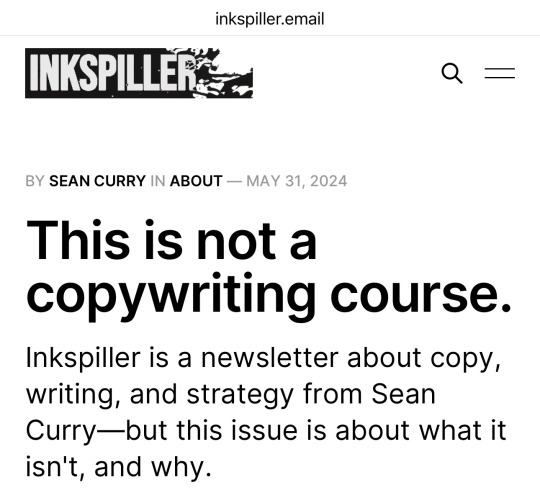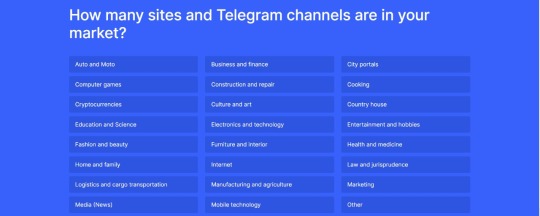#Content strategy
Explore tagged Tumblr posts
Text

Welcome to Inkspiller. Before we go any further, I want to be clear about one thing: this is not, and never will be, a copywriting course. There are enough of those. You don’t need another course slapped together by someone who completed a course themselves six months earlier. If all you do with what you gain from this newsletter is create another copywriting course, I’ll consider the entire endeavor a failure and close up shop.
Fair enough. What is this, then?
This is a newsletter about building a freelance copywriting career from a guy who’s been compensated for his writing since 2008, and who’s been successfully doing it freelance since he was fired from his last full time job in 2016.
Why are you doing it?
There is a lot of bad advice about freelance copywriting out there. If you’ve found your way here naturally (ie, if you don’t know me personally), then you’ve probably seen it. Starting a freelance copywriting career is hard enough as it is without having to sift through mountains of nonsense grifter BS to figure out which advice is actually worth listening to.
Who is this for?
What frustrates me the most about the majority of copywriting courses available today is how permanently they can turn aspiring writers away from this. If you’ve already paid over a grand to “gurus” and you still can’t figure out how to sign a client or keep them longer than one or two projects, you’re going to call the whole thing a wash and move onto something else.
That breaks my heart! I adore writing, and I value the independence my freelance status grants me over everything else in my professional life. I’m able to be at home and raise my kids, help run our household, and see friends. I’ve traveled more than I ever thought I would, funded a wedding and a house purchase, and paid off a lot of debt. I own my home, my income, and my time, and every time some huckster asshole tricks another newbie into forking over $500 in exchange for a Discord invite and 20 hours of watching someone talk into a webcam while screen-sharing a Google Doc, that path to independence gets closed off for someone else. That sucks.
I’m launching a professional newsletter about copywriting, Inkspiller!
Click to read the first issue, This is not a copywriting course.
And sign up at https://inkspiller.email/ to get these issues in your inbox every week.
33 notes
·
View notes
Text
♍︎
If you're a content creator and have Virgo placements, daily vlogs or videos like "day in my life" will be your best creations.
In astrology Virgo covers the everyday and mundane tasks, so showing your daily routine as a content creator is guaranteed to bring you good results.
#for creative direction consultations send a pm#astrology#divination#witchblr#spirituality#astro notes#astro observations#zodiac signs#horoscope#virgo#content strategy#work#business#career#entrepreneur
76 notes
·
View notes
Text

🚀 AI-Driven Tools Are at the Forefront of YouTube’s Latest Video Trends! 🎥🤖 From personalized recommendations to dynamic editing and analytics, AI tools are shaping the hottest video trends on YouTube. Creators are using AI to make engaging, innovative content that stands out and resonates with viewers. Dive into the future of video creation with AI leading the way! 💡✨ Click this link : https://tinyurl.com/fbhea698
#ai tools#youtube trends#video innovation#content creation#ai for creators#next level content#digital creativity#tech for youtube#ai impact#video editing#future of content#trending now#boost your channel#ai and video#tech tools#ai#creator community#digital#youtube tips#digital marketing#youtube growth#channel growth#content strategy
3 notes
·
View notes
Text
Cybersecurity vs. SaaS Marketing: Why Selling Security Is a Whole Different Game
Selling cybersecurity isn't the same as selling SaaS. This post explores the unique challenges and strategies involved in marketing security solutions. Learn why trust, risk aversion, and compliance play a crucial role in cybersecurity sales, and how to tailor your approach for success.

In the world of B2B tech, marketing cybersecurity solutions is like playing chess while everyone else is playing checkers. It's more complex, higher stakes, and requires a completely different strategy. This article dives into why marketing cybersecurity products is so different from selling your average SaaS solution, and why it matters for your business.
Think about it: When you're marketing a typical SaaS product, you're selling efficiency, productivity, or cost savings. But with cybersecurity? You're selling peace of mind in a digital world full of threats. It's not just about making life easier—it's about keeping businesses safe from invisible dangers.
Here's what we'll uncover:
Why cybersecurity products are trickier to explain (and sell)
How building trust is your secret weapon in security marketing
The constant race against new threats (and how it affects your marketing)
Why your customers might not know they need you (until it's too late)
Navigating the maze of regulations and compliance
Whether you're a marketer looking to level up your skills, a business owner trying to protect your digital assets, or just curious about how the world of cybersecurity ticks, this article will shed light on why marketing in this field is a unique challenge—and an exciting opportunity.
The Need for Specialized Marketing Skills in Cybersecurity
Before we dive into the specific differences, it's crucial to understand why cybersecurity marketing requires a specialized skill set:
Technical Proficiency: Cybersecurity marketers need a deep understanding of complex technical concepts to effectively communicate product value.
Risk Communication: Balancing the need to convey urgency without resorting to fear-mongering requires a nuanced approach.
Regulatory Knowledge: Familiarity with various compliance standards and regulations is essential for credible marketing in this space.
Rapid Adaptation: The ever-evolving threat landscape demands marketers who can quickly pivot strategies and messaging.
Trust Building: In a field where skepticism is high, marketers must excel at building and maintaining trust through every interaction.
Now, let's explore the five critical areas that make cybersecurity marketing a different beast from its SaaS counterparts, and learn how savvy marketers are rising to meet these challenges head-on.
1. Complexity of the Product
Cybersecurity Marketing
Cybersecurity solutions often involve intricate technologies and specialized knowledge. The products are designed to protect against sophisticated threats and vulnerabilities, which can be difficult for non-experts to fully grasp. As a result, cybersecurity marketers face the challenge of:
Simplifying complex concepts without losing their technical essence
Educating potential customers on the importance and functionality of various security measures
Balancing technical accuracy with accessibility to appeal to both IT professionals and business decision-makers
Specialized Skill: The ability to translate highly technical concepts into clear, compelling narratives that resonate with both technical and non-technical audiences.
Traditional SaaS Marketing
While SaaS products can also be complex, they often focus on solving more straightforward business problems. Marketers of traditional SaaS products typically:
Highlight user-friendly interfaces and intuitive functionality
Focus on immediate business benefits and ROI
Use less technical jargon in their marketing materials
2. Emphasis on Trust and Credibility
Cybersecurity Marketing
Trust is paramount in cybersecurity. Organizations are essentially entrusting their digital assets and sensitive information to the cybersecurity solution provider. To build this trust, cybersecurity marketers must:
Demonstrate deep expertise in the field
Showcase a proven track record of protecting against threats
Utilize case studies and customer testimonials extensively
Produce thought leadership content to establish authority
Highlight certifications, compliance, and industry recognition
Specialized Skill: The ability to build and maintain trust through every marketing touchpoint, from content creation to customer interactions.
Traditional SaaS Marketing
While trust is important for all SaaS products, the stakes are generally lower. Traditional SaaS marketers focus on:
User reviews and ratings
Ease of use and customer support
Integration capabilities with other tools
Cost-effectiveness and scalability
3. Rapidly Evolving Threat Landscape
Cybersecurity Marketing
The cybersecurity field is in a constant state of flux, with new threats emerging regularly. This dynamic environment requires cybersecurity marketers to:
Stay informed about the latest threats and trends
Quickly adapt marketing messages to address emerging challenges
Demonstrate how their solutions evolve to counter new risks
Educate the market about new types of threats and vulnerabilities
Position their products as forward-thinking and proactive
Specialized Skill: The ability to rapidly assimilate new information about emerging threats and translate it into compelling marketing messages and strategies.
Traditional SaaS Marketing
While innovation is important in SaaS, the pace of change is typically slower. SaaS marketers often focus on:
Long-term value proposition and stability
Gradual feature improvements and updates
Industry trends rather than immediate threats
4. Target Audience's Risk Awareness
Cybersecurity Marketing
Many organizations take a reactive approach to cybersecurity, only prioritizing it after experiencing a threat. This creates unique challenges and opportunities for marketers:
Educating potential clients about the importance of proactive measures
Using fear-based marketing carefully to highlight risks without being alarmist
Demonstrating the cost of inaction through real-world examples
Targeting both technical (CISOs, IT managers) and non-technical (CEOs, CFOs) decision-makers
Specialized Skill: The ability to effectively communicate risk and urgency without resorting to fear-mongering, while also tailoring messages to different stakeholders within an organization.
SaaS Marketing
Traditional SaaS products often address known pain points or inefficiencies. Marketers typically focus on:
Highlighting productivity gains and cost savings
Showcasing how the product solves existing problems
Appealing to a more defined set of decision-makers within an organization
5. Regulatory and Compliance Considerations
Cybersecurity Marketing
Cybersecurity solutions must often adhere to specific regulatory standards, adding another layer of complexity to marketing efforts:
Communicating compliance capabilities effectively
Addressing concerns related to data protection laws (e.g., GDPR, CCPA)
Highlighting adherence to industry-specific regulations (e.g., HIPAA for healthcare)
Demonstrating how the solution helps clients meet their own compliance requirements
Specialized Skill: A deep understanding of various regulatory frameworks and the ability to articulate how cybersecurity solutions address compliance requirements.
General SaaS Marketing
While some SaaS products may need to address compliance, it's typically not as central to the marketing message:
Focus on general data security and privacy features
Highlight any relevant certifications (e.g., SOC 2)
Address compliance as a feature rather than a core selling point
The Learning Curve for B2B SaaS Marketers
For B2B SaaS marketers transitioning into cybersecurity, the learning curve can be steep and time-consuming. Here's why:
Technical Knowledge Acquisition: Understanding the intricacies of cybersecurity technology, threat landscapes, and defense mechanisms requires significant study and often hands-on experience.
Regulatory Comprehension: Grasping the nuances of various compliance standards and their implications for different industries takes time and continuous learning.
Risk Communication Skills: Developing the ability to effectively communicate about risks without causing panic or disengagement is a delicate skill that takes practice to master.
Trust-Building Expertise: Learning how to establish and maintain trust in a highly skeptical market requires time to build credibility and refine communication strategies.
Rapid Adaptation Abilities: Cultivating the agility to quickly understand and respond to new threats and market changes is an ongoing process that improves with experience.
Cross-Functional Collaboration: Developing the ability to work effectively with technical teams, compliance officers, and C-suite executives requires time to build relationships and understand diverse perspectives.
Industry-Specific Knowledge: Each industry (e.g., healthcare, finance, government) has unique cybersecurity needs and regulations, requiring marketers to develop sector-specific expertise.
Typically, it can take 2-3 years for a B2B SaaS marketer to become proficient in cybersecurity marketing, and 3-5 years to be considered an expert in the field. This timeline can vary based on the individual's background, the complexity of the cybersecurity solutions they're marketing, and the resources available for professional development.
Conclusion
Marketing cybersecurity solutions requires a unique approach that goes beyond traditional SaaS marketing strategies. The complexity of the products, the critical need for trust and credibility, the rapidly changing threat landscape, the varying levels of risk awareness among potential clients, and the intricate regulatory environment all contribute to making cybersecurity marketing a distinct challenge.
Successful cybersecurity marketers must balance technical expertise with clear communication, educate their audience while building trust, and stay agile in response to new threats and regulations. By understanding these key differences and investing in specialized skills, marketers can create more effective strategies that resonate with the specific needs and concerns of the cybersecurity market.
For B2B SaaS marketers looking to transition into this field, patience and dedication are key. The journey to becoming a proficient cybersecurity marketer is demanding but rewarding, offering the opportunity to play a crucial role in protecting organizations and individuals in our increasingly digital world.
Visit for more info: https://gracker.ai/
#seo services#seo strategy#content strategy#search engine optimisation#seo marketing#blog strategy#cybersecurity#content creation#ai generated#content marketing
3 notes
·
View notes
Text
"So, you're not an artist, but you give people advice on how to become one?”
#quote of the day#art#quotes#Influencer#scammers#fruad#scam alert#artist#content creator#คำคม#money#greed#bullshit#fake#lie#self realization#know thyself#joke#funny#shameful#life#meaning of life#content marketing#content strategy#marketing#advertising
4 notes
·
View notes
Text
Collaborator: Content & Influencer Marketing Marketplace, Unlocking Revenue with Content
Turn your content into Revenue!
In today's digital landscape, maximizing the reach of your content is crucial for success. Collaborator offers a comprehensive solution to turn your content into revenue through strategic partnerships with carefully selected websites and Telegram channels.

Key Features:
Wide Reach: Access to 30,887 high-quality sites and 2,890 Telegram channels in 143 countries and 50 languages.
Data-Driven Selection: Utilize factual data confirmed by Google Analytics and integrate with Ahrefs for comprehensive insights.
Low Fees: Enjoy affordable rates and receive assistance in choosing the most suitable sites for your content.
Data Privacy: Ensuring the security of your content and transactions is a top priority.


Advantages of Collaborator:
Speed: Rapid processes from site selection to deal processing, with an average turnaround time of just 2 days.
Quality Selection: Choose from a wide array of high-quality sites, filtered by traffic, domain rating (DR), and other SEO parameters.
Integration: Seamlessly integrate with Ahrefs and Serpstat to access essential metrics within the Collaborator interface.
Security: Ensure the safety of your content with secure transactions and monitoring.
Transparency: Gain clarity on where your content will be published, ensuring alignment with your objectives.
Guest Posting Made Easy:
Popular Strategy: Guest posting remains one of the most effective strategies to amplify your content's reach.
Challenges: It can be daunting to secure guest posting opportunities on reputable platforms without an established reputation.
Collaborator's Solution: With over 19,000 sites across 36 themes, Collaborator simplifies the process of finding relevant resources for guest posting.
Advantages: Enjoy swift processes, a vast selection of high-quality sites, integration with SEO tools, and enhanced security measures.
Ease of Use:
Intuitive Interface: Navigating the catalog and ordering guest post placements is simple and user-friendly.
Master Account Functionality: Ideal for managing outreach teams and optimizing collaboration efforts.
On-Page Optimization Checklist: Access a comprehensive checklist for auditing and improving your on-page SEO.
With its extensive network, data-driven approach, and user-friendly interface, Collaborator empowers content creators to thrive in the digital landscape.
Join Collaborator today and start turning your content into success!
Affiliate Disclosure: This post contains affiliate links. If you buy a product or service recommended on this blog, you won’t pay a penny more, but we may receive a small commission to help keep the blog running. Thank you so much for your support!
#guest post#contentmarketing#influencer marketing#digital marketing#content strategy#content marketing#seo#seo services#search engine optimization#search engine optimisation services#online marketing#digitalstrategy#content creator#colonialism#solar eclipse#mlp#hermitcraft#witchcraft#studio ghibli#911 abc#stardew valley#israel#wwe#dimension 20#genshin impact#fallout#sunrise#hades 2#wellness#the sandman
7 notes
·
View notes
Text
How WhistlinDiesel Revolutionized Car Reviews
With automotive content, traditional car reviews have long followed a familiar formula: polished shots of vehicles, technical specifications, and reserved commentary on performance. However, with the rise of platforms like YouTube and social media, this formula has been challenged. One creator who stands out in this shift is WhistlinDiesel. Known for his unconventional and often extreme approach,…
#audience engagement#authentic reviews#authenticity#Automotive#automotive brands#automotive creator#automotive industry#automotive journalism#automotive trends#Car Culture#car enthusiasts#car reviews#cars#Cody Detwiler#Community#content creator#content evolution#content strategy#destruction testing#digital content#Durability#entertainment#extreme content#extreme testing#influence#innovation#new media#off-road#online reviews#raw reviews
3 notes
·
View notes
Text
#content marketing#content creation#content strategy#influencer marketing#seo services#search engine optimization
14 notes
·
View notes
Text









Are you finding it challenging to link your content strategy with SEO goals? Check out our latest post for straightforward tips on how to bridge that gap. Learn practical steps to improve your strategy and boost your online impact. 🚀
#digital marketing#tumbler#openai#seo services#google#content strategy#marketing tips#content creation#search engine optimization#ai
2 notes
·
View notes
Text
📝 Unlocking the Secrets of Content Strategy 📝
Content strategy isn't just about posting eye-catching visuals or crafting witty captions; it's a strategic endeavor aimed at achieving specific objectives and resonating with a target audience. It involves an understanding of audience preferences, the creation of compelling content that adds value, and the maintenance of consistency across various platforms.
Now, let's connect the dots between these conceptual musings and my Content Analysis Project. The data I'm diligently collecting serves as a treasure trove of insights into content strategy in action. By scrutinizing the engagement metrics of cat influencers, I can draw several compelling conclusions:
The data reveals how different content types and posting frequencies impact audience engagement. By analyzing likes, comments, and plays, I can discern which content resonates most with the audience and tailor future strategies accordingly.
Through data analysis, I can identify which content strategies yield the highest engagement rates. Whether it's captivating images, engaging videos, or thought-provoking captions, the data provides valuable feedback on the effectiveness of various content approaches.
Content strategy hinges on maintaining consistency and cohesion across platforms. By examining engagement trends over time, I can assess the consistency of content delivery and identify areas for improvement in maintaining a cohesive brand image.
This project serves as a conduit for unraveling the intricacies of content strategy. By scrutinizing the data collected from cat influencers, I can draw actionable conclusions about effective content creation, audience engagement, and brand consistency! 🚀💡
4 notes
·
View notes
Text
The Unspent Energy at the Bottom of the Page - Inkspiller

Set up your argument
Many people default to the Descending Copy Ladder to Hell when they write for reasons I already discussed here, and a big one is a lack of awareness about messaging frameworks. It sounds complicated, but it’s just the skeleton of your piece. If your skeleton is strong, then you’ll be easily able to hang the meat-copy up on it later.
Have you ever seen a body without a skeleton? It’s just a pile of meat on the floor. No one likes a pile of meat on the floor.
A good framework is topic-agnostic, because it has nothing to do with the topic itself. Messaging frameworks are entirely about how you communicate your message to your audience, regardless of the topic of your message, and how you build up energy you will later convert into action.
Here’s a simple one I almost always default to:
State the problem
Create urgency
Offer a solution
State the problem
Your readership may or may not already be aware of the problem you want to offer a solution to. If they’re not aware, then you’re making them aware. If they already are, then you’re telling them they’re about to learn how to solve it.
A lot of copy I’m asked to critique gets this wrong in one of two ways: either they don’t state the problem they’re offering a solution to until they’re 75% of the way through the piece, or they spend the first 75% of the piece stating the problem. State the problem early and briefly, follow up with an emotional truth or supporting evidence to show you’re not making it up, and move on.
Create urgency
Your reader knows there’s a problem now—great! Why should they care? Show them why this problem is something they need a solution for now. If you do this part well, they’ll be convinced they need a solution even if they don’t go with your solution.*
Copy that drones on about the problem and belabors the point fails to make it urgent. The reader wants to be led, but they want to know they’re being led to something. Raising the stakes shows them that where they are now in your argument is different from where they were before. It gives them direction. Show them why they’ll be unhappy if they don’t take action now, and move onto the solution you want them to choose.
Offer a solution
Dear Reader understands the problem and why it requires immediate action. You’ve alley-ed, now it’s time for that sweet, sweet -oop. Give them the solution you’ve got them begging for. If you’ve done the previous two parts right, they might even already know what that solution is.
Most of the copy I see in critique requests actually does this! They could certainly do it with fewer words (which, to be fair, is universally and eternally true across all levels of skill and experience), but the solution is always presented, and sometimes even with a few supporting Reasons To Buy/Believe (RTBs). Which is great! You’ve done it! Now it’s time to bring them home with a…
…where are you going? Why is the page over? How do they take advantage of the solution you’ve just sold them on??
--
I wrote about messaging frameworks, building energy over a page, and most importantly, giving that energy somewhere to go at the end of the page in my latest for Inkspiller.
Click here to read, and grab FREE full access to Inkspiller all summer long here: Summer Spiller.
8 notes
·
View notes
Text
If you are an artist and are wondering what content to do at the moment, you should post about the process of creating your art pieces.
Since the Sun is in Virgo, this type of content will bring you lots of attention.
#art#artist#artists on tumblr#digital artist#astrology#divination#spirituality#marketing#content strategy#digital marketing#creative inspiration#creative strategy
11 notes
·
View notes
Text
Multilingual vs Multinational SEO-Decode Global Reach
Discover the key differences between multinational and multilingual SEO, and learn how to optimize your online presence for international success. [Continue reading for more] Multinational SEO: Targeting Customers WorldwideMultilingual SEO: Optimizing for Multiple LanguagesCombining Multinational and Multilingual SEOExpert Tip: Leverage Transcreation for Multilingual SEOSuggestion: Conduct…
#audience targeting#business strategy#marketing strategy#subham das#SEO#digital marketing#global strategy#multilingual SEO#multinational SEO#international SEO#web optimization#content strategy#global reach#search engine optimization#language localization#country-specific SEO#global audience#online marketing#traffic boost#user preferences#local domains#subdomains#website translation#e-commerce#regional preferences#business growth#digital strategy#online presence#language diversity#search habits
2 notes
·
View notes
Text

#creative writing#writers on tumblr#spilled words#content creation#content writing#content strategy#sign language#deafawareness#asl#pensitively yours#quotes#american sign language#language of love#sign language love#humanity#people being people#communicate with love
8 notes
·
View notes
Text
How To Create A Content Marketing Strategy For Your SaaS Business

Whether you're starting conversations that engage your target audience, sharing information that positions your SaaS business as an industry leader, or simply drumming up business for your SaaS product, you need an effective SaaS content marketing strategy.
Why you may ask?
Because 63% of customers cite web pages during their evaluation process. And on the average, companies that blog receive 434% more indexed pages. If, on an industry-wide scale, you have nearly 10 times more leads from long form blog posts than short ones, then content marketing is a priority if you want to grow your SaaS business long term.
In this guide, we'll discuss SaaS content marketing strategy. And by the end, you'll know what content strategy is, why you need one and when to apply it. Then you'll get a step-by-step process of creating a content strategy unique to your SaaS business.
Defining SaaS Content Strategy

If you don't understand content strategy, we'll explain what it is before we get to the why and when.
So what is content strategy?
Content strategy is simply all the content processes a business employs to get prospects to buy their product or service. There's
#Audience Research
#Business Model
#Content Ideation
#Media Platforms
#Content Creation
#Distribution &
#Evaluation
And as a SaaS business owner, SaaS content strategy is simply a content strategy that accounts for your SaaS business model.
SaaS companies like Canva, Buffer and HubSpot have executed robust content marketing strategies that have scaled their lead generation and subscription efforts.
Specifically, Grammarly has a blog that educates their readers on writing styles and technique. Their blog has over 100,000 subscribers and their content has over 5 million views.
These readers get freemium access to their editing tool. They number 30 million users. And a good number of these readers end up paying for their editing software.
As a SaaS business owner, you can aim for similar success, cheap and exponential business growth, with an effective SaaS content strategy.
Benefit Of SaaS Content Strategy

Focus stands out amongst content strategy benefits like exponential growth and cheap lead generation. Joe Pulizzi stressed the importance of content strategy and expanded on focus as a SaaS content strategy benefit when he said this…
"We need to create a business strategy for our content. That means saying no to many channels and content types, and focus on where we can build an asset, an audience, overtime."
- Joe Pulizzi
A good SaaS content strategy saves time and energy that would otherwise be spent talking to the void. Strategy quickly gets you closer to what works. By studying your target market, you discover not just what to say, but where and when to say it.
Let's take HubSpot for instance here.
HubSpot's blog posts are comprehensive guides to unlock business growth via sales and marketing. Their blog content has a strong bias towards explaining theories and practices. But on their Instagram page, we observe something different. Content is more conversational and personable. Learning takes a back seat to experience and entertainment.
Their blog readers and Instagram followers are different. And even when these audiences overlap, we see different attitudes for different platforms. And in this case, the same lead is in a different mindset depending on which platform they consume HubSpot's content.
We can see that HubSpot's approach to content creation and distribution considers platform culture when talking about the same topics. These content strategy insights come from studying market behavior on search engines and different social media platforms.
So now they don't have to work mindlessly. They have knowledge and a plan on how to use relevant content to generate leads and sales.
This is the process of creating a content strategy and you can do the same for your SaaS business.
When To Use SaaS Content Strategy

From time to time, I find founders and aspiring entrepreneurs asking when to use content strategy in their business.
My answer?
Start as soon as you can. In fact, you should have started yesterday even if you don't have a product or market. Surprised? Let me explain.
Early Stage SaaS Companies
You see, a content strategy is valuable because of what it makes you do. You can't have a strategy to engage a market if you first don't know your core service or product, and who would need your offer.
Say you're a digital marketer helping e-commerce stores increase website traffic. And you hope to sell software services to e-commerce store owners in the future. You could use a content strategy where you document your process of helping e-commerce websites grow their traffic.
Now you're engaging your market while figuring out other problems they may have that would be worth a SaaS tool. Before UberSuggest, Neil Patel ran his digital marketing blog for many years. He offered educational content to digital marketers and online entrepreneurs on how to grow their businesses. Now his SaaS tool, UberSuggest, helps entrepreneurs with keywords for their content marketing efforts.
Established SaaS Companies
On the other hand, established SaaS businesses can improve the value of their business by having another option to generate leads and sales. Outbound processes like cold calling and emailing can be effective and sustainable. But adding inbound processes like content marketing to the mix increase lead gen options and strengthens outbound processes too.
Regardless of where you are in your SaaS journey, creating a good SaaS content strategy keeps you in touch with your product and market.
Now having understood what a SaaS content strategy is and can do, let's get into the weeds of creating one.
Defining Your Market

All effective SaaS content strategy starts out with a defined market. As a SaaS business owner, ask yourself these questions…
Who needs what you sell?
Why do they have this need?
What would they feel like when said need is satisfied?
What else do they do outside finding said satisfaction?
These questions give you an opportunity to understand your market. Say you sell business software to freelance writers and content creators. Freelance writers and content creators need high paying clients and commercial success with their audience respectively.
But is that all?
It isn't. Dig deeper.
For a freelance writer, higher paying clients mean
Reduced Anxiety
Meaningful Work &
Time Freedom
And for the content creator, a profitable product they own means
Income Stability
Creative Freedom &
Work Satisfaction
As an owner of your business software, you now know what your editing or invoice software actually means to your market. You know their needs and what they'll feel like when satisfied.
So it's time to find them.
SaaS Content Strategy Platforms

We've answered the above questions for your hypothetical software business except for what content creators and freelance writers do outside their core jobs.
Answering the last question brings up more questions…
Do they consume business content from online gurus?
Do they take courses from fellow writers and bloggers?
What about search and social groups where they interact with fellow content creators and freelancers?
Remember, we're trying to find out their hangout spots online. So wherever they spend their time online is a potential content strategy platform. Content strategy platforms are places that shape your tone and approach to creating engaging content that converts prospects.
You can speak with your customers to get an idea of how they spend their online hours when they're not working. Of course you can't go around asking awkward questions like
'Where do you spend your time online?'.
Instead, you can say something like
'What's your most inspiring piece of educational content in the last 2 months?'
'Who's making content that gets you excited?'
'What obstacles do you face that often hinder your productivity?' (By the way, whoever is offering courses or creating content to solve that problem is a potential content strategy platform.)
Get a list of these content strategy platforms and go to work studying your market. You'll find yourself in reddit channels, comment sections of Instagram accounts and YouTube channels. You'll pick up Twitter trends and read blog comments.
Before long, the picture of your market becomes clear. You'll be full of content and distribution ideas for your content marketing campaign. Your SEO keyword search would be much more robust instead of staring at keyword software charts with frustration.
Back to our hypothetical software business. Your market research would take you to content strategy platforms like Ali Abdaal, Dan Koe, Zulie Rane, Gary Vee and Roberto Blake. These creators serve the typical content creator and freelance writer. Observe how they talk and what they talk about in the comment sections of these influencer accounts.
Now you know exactly what your market wants and you know how to create content for them.
It's time to engage and convert.
Engaging And Converting Your Audience

Many SaaS companies get it right up to this point but skid off track at this crucial bend. They lose because they want to engage their prospects on the company's terms. Don't make that mistake.
Remember our earlier conversation about HubSpot's approach to their blog and Instagram accounts?
Good.
They observed that business owners on search engines such as Google, have search intent to learn about new information and products to solve business problems. So HubSpot's blog attracts them with big prominent blog titles and small author bylines.
Blog Titles

Picture of HubSpot's SERP
Blog Titles and Author Bylines

Picture of HubSpot's Blog Post
You get the sense that it's ideas first before people. On the other hand, business owners and professionals who want to unwind while being social on Instagram, dictate HubSpot's Instagram approach to content creation. Here, social interaction and entertainment are priority over ideas and education.
Personality Over Theory

Picture of HubSpot's Instagram account
It's not enough to create content, you have to do so native to each platform. This is where strategy bleeds into tactics. Let's talk team building.
Building A Content Team
Having understood what it takes to create a practical SaaS content strategy, it's time to roll up your sleeves and get to tactics. You could start solo but at some point, you'd need to build a team.
We'll examine 4 factors that determine the success of your team. They're
Vision
Roles
Collaboration &
Accountability
We'll begin with vision.
Vision
Your vision is volume and creativity. You have a SaaS content strategy and ideas to engage your prospects. But to get results, you need to create and distribute as much content as possible.
We're talking 20-30 social media posts daily with at least 3-10 social engagements per post. Write blog posts, record podcasts and YouTube videos on a daily basis. Repurpose your long form posts for social. You want to find what sticks.
This is hard work but that's the real secret to content marketing success.
Especially at the beginning, you have to find out what actually works. So volume and creativity is the vision when hiring a content marketing team. At such volume, in 3-5 years, you'll evaluate content activity and do more of what engages your market. And consistent sales roll in.
There are no shortcuts to this game. It's not a sprint or a marathon, it's both. The long hard road is the easiest and shortest one. Get to work. As entrepreneurs, we instinctively understand that outbound processes like cold calling are a numbers game but we don't apply it to content marketing.
There are so many intangible content marketing skills that can only be mastered via the fire hose approach. So when building your content marketing team, your overarching vision is that big is better.
Roles
You want big and better, so it's time to get you a content marketing team who can achieve your goals. I'd say that there are 3 major content marketing roles.
Director
Manager &
Creative
When you were creating your content marketing strategy for your hypothetical SaaS company, you played the director role. In addition to setting the vision for content strategy, a director of content analyses and adjusts content efforts to achieve customer and company goals.
The manager is in charge of content production and adjacent processes. They hire creatives, supervise them and build systems that guarantee the right flow of content creation and distribution.
Creatives create content assets, engage with professionals within your business and prospects via content strategy platforms. They also collaborate with both manager and director to improve their creative processes.
Collaboration
Team collaboration with each other and the larger organization decides success. On the director level, they have to find a balance between customer satisfaction and company goals.
When creating a content strategy, these 2 criteria guide the content strategy process. Many times, the director is the link between C-suite and the content marketing branch of the company.
The manager, in many ways, is the middleman. They make strategy, from the director, and tactics from creatives, align. Giving strategy legs, and tactics direction, leads to a successful conveyor belt of content assets and development of customer-company relationships.
Creatives who collaborate effectively with their managers, get to do meaningful and result-driven work.
Accountability
Accountability is probably the only way to see through projects. We'll look at 3 ways to hold both you and the team accountable for your roles.
I. Set Realistic Goals
At the beginning you want the team to start with small achievable goals. A social media content creator who hasn't done more than 5 posts a day shouldn't start their first day on the job creating 30 social media posts daily.
II. Set General Guidelines And Standards
Something as simple as adequate communication during work hours should be basic. Team chats and emails shouldn't be left unattended for 3 days without prior notification of a new development. Team members should attend meetings.
III. Assign Specific Tasks To Individual
A good example here would be creatives being in charge of content creation and distribution. They're not responsible for engagement results. That's the responsibility of the manager and director.
Conclusion
As we draw this guide to a close, it's important to note that content marketing strategy will always be worth its business results. And since ever-changing markets affect business results, you'll always have to evaluate your tactics and strategy.
At the beginning of your content marketing efforts, a strategy, content schedule and distribution map, should be the goal. It isn't about the number of views as it's about the number of content pieces you create. And that's why volume is important.
A year or 2 into this flurry of activity, all content strategy platforms would show noticeable patterns of engagement. Some content pieces would have more engagement than others. This is where evaluation comes in.
Ditch what doesn't work and do more of what does. Scaling what works at this point would grow views and traffic. Just as we discussed, content marketing strategy is the first in a series of steps to generate leads and sales for your business.
If you have further questions about SaaS content strategy or content marketing in general, leave a comment below and it'll be addressed.
#contentmarketing#content writing#marketing#saas technology#b2b saas#saas#saasmarketing#saas solutions#saas software#content strategy#content marketing
4 notes
·
View notes